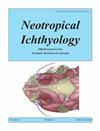巴西东北海岸的一支沿海手工船队捕获了三条狐尾鲨的体型和性别组成
IF 2
4区 生物学
Q1 ZOOLOGY
引用次数: 0
摘要
鲨鱼是受密集渔业影响最大的海洋生物之一,这是一个令人担忧的事实,因为它们是生态系统营养结构的关键组成部分。在这种情况下,鱼类上岸数据可以帮助管理人员保护鲨鱼。本研究对1998-1999年、2006-2008年和2015-2016年三个研究时期(Carcharhinus acronotus、Mustelus cfc . canis和Sphyrna mokarran)在巴西塞勒本文章由计算机程序翻译,如有差异,请以英文原文为准。
Size and sex composition of three carcharhiniform sharks landed by a coastal artisanal fleet from the northeastern coast of Brazil
Abstract Sharks are among the marine organisms most impacted by intense fisheries, a worrying fact since they are key components in the trophic structure of ecosystems. In this context, fish landing data can help managers in shark conservation. This study characterized the landings of Carcharhinus acronotus, Mustelus cf. canis, and Sphyrna mokarran in the Mucuripe Embayment, Ceará, Brazil, along three study periods (1998–1999, 2006–2008, and 2015–2016). A total of 223 specimens were recorded from 227 site visits. Carcharhinus acronotus specimens measured from 50 to 139 cm in total length (TL), with a 1.3:1 sex ratio in favor of males. Most of the specimens recorded were adults (55.1% of males and 62.9% of females). Mustelus cf. canis varied from 64 to 133 cm in TL, with a sex ratio in favor of females (3.1:1). Most of the specimens recorded were adults (50% of males and 68% of females). Sphyrna mokarran specimens varied from 116 to 380 cm in TL, with a sex ratio of 7:1 in favor of males. Most of the specimens recorded were juveniles. This is the first fishery-dependent study to provide information on size and sex composition of these species for most of the southwestern equatorial Atlantic.
求助全文
通过发布文献求助,成功后即可免费获取论文全文。
去求助
来源期刊

Neotropical Ichthyology
生物-动物学
CiteScore
2.80
自引率
17.60%
发文量
24
审稿时长
6-12 weeks
期刊介绍:
Neotropical Ichthyology is the official journal of the Sociedade Brasileira de Ictiologia (SBI). It is an international peer-reviewed Open Access periodical that publishes original articles and reviews exclusively on Neotropical freshwater and marine fishes and constitutes an International Forum to disclose and discuss results of original research on the diversity of marine, estuarine and freshwater Neotropical fishes.
-Frequency: Four issues per year published only online since 2020, using the ‘rolling pass’ system, which posts articles online immediately as soon as they are ready for publication. A searchable and citable Digital Object Identifier (DOI) is assigned to each article immediately after online publication, with no need to await the issue’s closing.
-Areas of interest: Biology, Biochemistry and Physiology, Ecology, Ethology, Genetics and Molecular Biology, Systematics.
-Peer review process: The Editor-in-Chief screens each manuscript submitted to Neotropical Ichthyology to verify whether it is within the journal’s scope and policy, presents original research and follows the journal’s guidelines. After passing through the initial screening, articles are assigned to a Section Editor, who then assigns an Associate Editor to start the single blind review process.
 求助内容:
求助内容: 应助结果提醒方式:
应助结果提醒方式:


